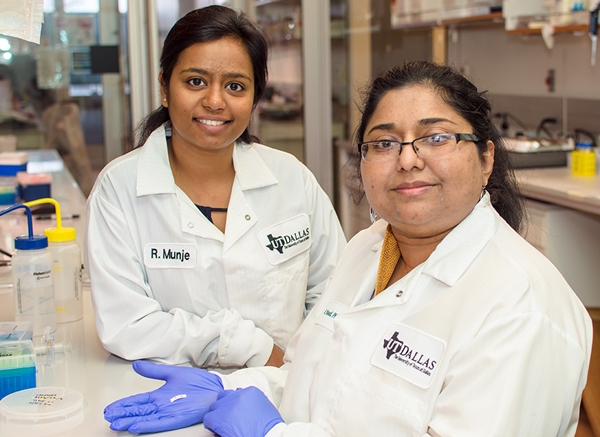
Shalini Prasad, right, holds a glucose biosensor, developed with first author Rujuta Munje. (Univ of Texas, Dallas)
14 October 2016. A bioengineering lab at University of Texas in Dallas developed a miniature biosensor device that measures blood glucose levels from a person’s perspiration. A description of the system appears in the January 2017 issue of the journal Sensors and Actuators B: Chemical (paid subscription required).
Researchers from the lab UT-Dallas of engineering professor Shalini Prasad are seeking a a simple and easily deployable alternative to conventional glucose meters used by people with diabetes that require periodic minute blood samples, usually from a finger prick. Diabetes is a chronic disorder where the pancreas does not create enough insulin to process the sugar glucose flowing into the blood stream and provide energy for cells in the body. According to the International Diabetes Federation, diabetes affects 415 million people worldwide, of which 44 million are in North America.
Prasad and doctoral candidate Rujuta Munje, first author of the journal article, adapted the same principle of the testing strips to measure glucose in blood to a device that can be worn continuously by an individual next to the skin, such as under a watchband or in a skin patch. The device, however, had to work with a small amount of sweat, and without sending a current through the skin to generate perspiration, as some current techniques that can burn the skin.
The UT-Dallas team integrated gold and zinc oxide materials to detect blood glucose into a polyamide fabric as used in fitness wear that wicks perspiration from the skin. “We used known properties of textiles and weaves in our design,” says Prasad in a university statement. “What was innovative was the way we incorporated and positioned the electrodes onto this textile in such a way that allows a very small volume of sweat to spread effectively through the surface.”
The device itself is about an inch long with two electrodes woven into the fabric, with engineered antibodies that amplify the glucose residue. This design enables the device to detect and measure blood glucose levels in perspiration amounts as small as 1 microliter, about the same volume as a salt crystal. The team in an earlier study showed a similar device could measure cortisol, a hormone released by the body when under stress.
In lab tests with the device, the researchers measured blood glucose and cortisol with the sensor, with results compared to a commercial glucose meter. The results show a high (0.9) correlation between the sensor and the glucose meter. Further tests using electrochemical resistance measurements demonstrated the device could measure glucose in human sweat, even in the presence of cortisol. “We have shown,” adds Prasad, “that with our technology, we address three critical issues: low volume of ambient sweat, interference from other compounds, and pH swings.”
From the beginning of the project, the team designed the device with commercialization in mind. “At this point,” Prasad notes, “we are thinking of this sensor as something you use for a day and toss out, and we believe it could easily be incorporated into existing consumer electronics platforms.” Co-author Sriram Muthukumar, is an adjunct professor in materials science and engineering at UT-Dallas, as well as principle in the start-up biosensor company EnLisense LLC in nearby Allen, Texas.
Read more:
- FDA Clears Artificial Pancreas System for Type 1 Diabetes
- Sanofi, Alphabet Create Diabetes Venture
- Glucose Drug Reduces Heart Disease in People with Diabetes
- Clinical Center, Mobile Developer Partner on Diabetes Apps
- Sanofi Adopting Big Data for Diabetes Drug Adherence
* * *

 RSS - Posts
RSS - Posts
[…] Sweat Sensor Devised for Blood Glucose Measurement […]